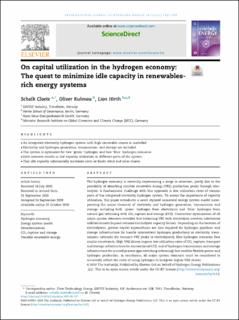| dc.contributor.author | Cloete, Schalk Willem Petrus | |
| dc.contributor.author | Ruhnau, Oliver | |
| dc.contributor.author | Hirth, Lion | |
| dc.date.accessioned | 2022-10-10T10:32:02Z | |
| dc.date.available | 2022-10-10T10:32:02Z | |
| dc.date.created | 2021-02-11T09:58:19Z | |
| dc.date.issued | 2020 | |
| dc.identifier.citation | International Journal of Hydrogen Energy. 2020, 46 (1), 169-188. | en_US |
| dc.identifier.issn | 0360-3199 | |
| dc.identifier.uri | https://hdl.handle.net/11250/3025055 | |
| dc.description.abstract | The hydrogen economy is currently experiencing a surge in attention, partly due to the possibility of absorbing variable renewable energy (VRE) production peaks through electrolysis. A fundamental challenge with this approach is low utilization rates of various parts of the integrated electricity-hydrogen system. To assess the importance of capacity utilization, this paper introduces a novel stylized numerical energy system model incorporating the major elements of electricity and hydrogen generation, transmission and storage, including both “green” hydrogen from electrolysis and “blue” hydrogen from natural gas reforming with CO2 capture and storage (CCS). Concurrent optimization of all major system elements revealed that balancing VRE with electrolysis involves substantial additional costs beyond reduced electrolyzer capacity factors. Depending on the location of electrolyzers, greater capital expenditures are also required for hydrogen pipelines and storage infrastructure (to handle intermittent hydrogen production) or electricity transmission networks (to transmit VRE peaks to electrolyzers). Blue hydrogen scenarios face similar constraints. High VRE shares impose low utilization rates of CO2 capture, transport and storage infrastructure for conventional CCS, and of hydrogen transmission and storage infrastructure for a novel process (gas switching reforming) that enables flexible power and hydrogen production. In conclusion, all major system elements must be considered to accurately reflect the costs of using hydrogen to integrate higher VRE shares. | en_US |
| dc.language.iso | eng | en_US |
| dc.publisher | Elsevier | en_US |
| dc.rights | Navngivelse 4.0 Internasjonal | * |
| dc.rights.uri | http://creativecommons.org/licenses/by/4.0/deed.no | * |
| dc.subject | Variable renewable energy | en_US |
| dc.subject | CO2 capture and storage | en_US |
| dc.subject | Decarbonization | en_US |
| dc.subject | Energy system model | en_US |
| dc.subject | Hydrogen economy | en_US |
| dc.title | On capital utilization in the hydrogen economy: The quest to minimize idle capacity in renewables-rich energy systems | en_US |
| dc.type | Peer reviewed | en_US |
| dc.type | Journal article | en_US |
| dc.description.version | publishedVersion | en_US |
| dc.rights.holder | © 2020 The Author(s). Published by Elsevier Ltd | en_US |
| dc.source.pagenumber | 169-188 | en_US |
| dc.source.volume | 46 | en_US |
| dc.source.journal | International Journal of Hydrogen Energy | en_US |
| dc.source.issue | 1 | en_US |
| dc.identifier.doi | 10.1016/j.ijhydene.2020.09.197 | |
| dc.identifier.cristin | 1888746 | |
| cristin.ispublished | true | |
| cristin.fulltext | original | |
| cristin.qualitycode | 1 | |

